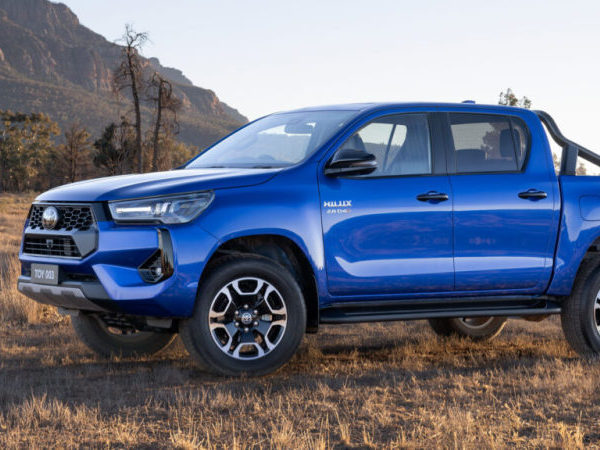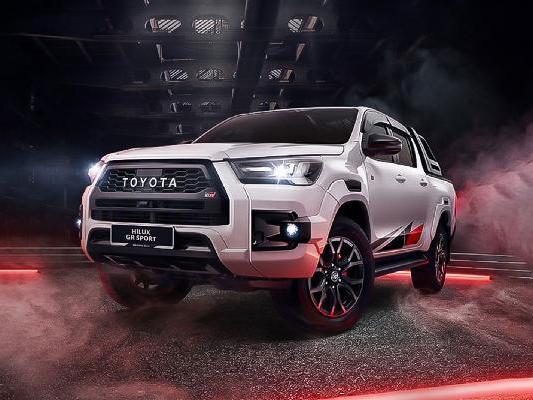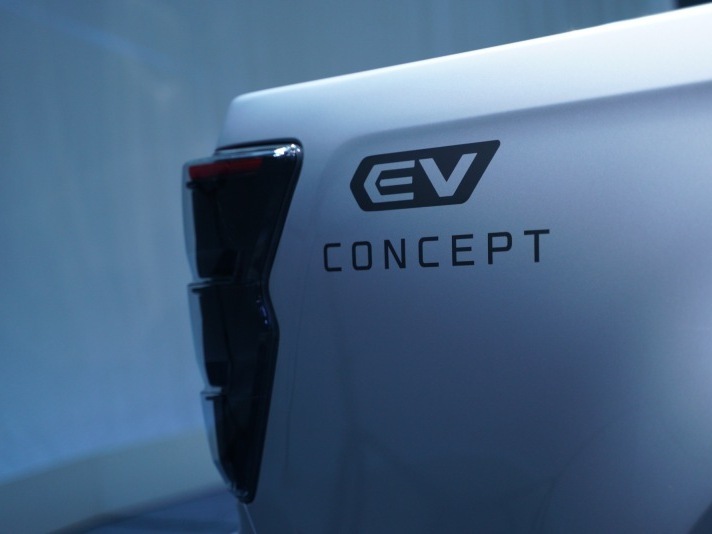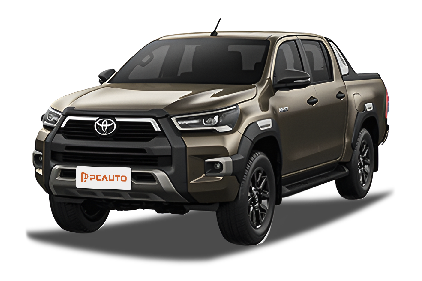Q
What kind of engine is in the Toyota Hilux 2023?
The 2023 Toyota Hilux in Malaysia comes with two efficient diesel engine options from the GD series: a 2.4-liter and a 2.8-liter turbocharged unit. The 2.4-liter puts out 150 horsepower and 400 Nm of torque, while the 2.8-liter cranks out 204 horsepower and 500 Nm when paired with the 6-speed automatic transmission. Both engines feature Toyota's advanced common-rail direct injection and variable geometry turbocharger, balancing power delivery and fuel efficiency—perfect for Malaysia's diverse road conditions, whether you're navigating city streets or tackling light off-road trails. What's really nice is that the GD engines have an optimized combustion chamber design and reduced internal friction, which cuts down on noise and vibration for a smoother drive. If you're someone who regularly hauls cargo or tows, the 2.8-liter's high torque is a game-changer, while the 2.4-liter makes more sense if you're watching your daily running costs. Toyota has also fitted both engines with a DPF (Diesel Particulate Filter) to meet Malaysia's latest emission standards, showing the brand's commitment to eco-friendly tech.
Special Disclaimer: This content is published by users and does not represent the views or position of PCauto.
Related Q&A
Q
What is the most reliable car in the world Hilux?
The Toyota Hilux is widely regarded as one of the most reliable vehicles on the planet, and it really shines in places like Malaysia with its tropical climate and varied terrain. Its durability and low breakdown rate have earned it the trust of countless owners. The diesel engine under the hood isn't just fuel-efficient; it handles all sorts of rough roads like a champ. Throw in Toyota's usual top-notch build quality, and it's no wonder it's been a leader in the pickup truck market for so long. On top of that, maintenance costs are pretty reasonable, and parts are easy to come by – huge pluses for Malaysian buyers. It's worth remembering, though, that reliability isn't just about the brand or model. Regular upkeep and good driving habits matter too – things like changing the oil on time and checking the brakes can really extend your vehicle's life. If you're thinking about getting a Hilux, take a look at your own needs, like how much you need to haul or how often you'll go off-roading, to see if it's the right fit. And don't forget to check out what local owners have to say about their real-world experiences before making your call.
Q
What is the fuel economy of the Hilux 2023?
The 2023 Toyota Hilux offers varying fuel efficiency in the Malaysian market depending on the powertrain. Models equipped with the 2.4-liter turbo diesel engine deliver a combined fuel consumption of approximately 7.5-8.0 liters per 100 kilometers, while the 2.8-liter diesel version is slightly higher at around 8.0-8.5 liters per 100 kilometers. Actual figures may vary based on driving habits, road conditions, and vehicle load. This pickup truck continues Toyota's legacy of durability and practicality, making it well-suited for Malaysia's diverse terrain and long-distance driving needs. To further improve fuel efficiency, it's advisable to perform regular vehicle maintenance, maintain proper tire pressure, and avoid aggressive acceleration and braking. As one of the most popular pickup trucks in Malaysia, the Hilux strikes a balanced fuel economy in its class, combining performance with daily running costs, making it a reliable choice for both commercial and personal use.
Q
How reliable is the 2023 Toyota?
In 2023, Toyota maintained its brand's consistent high standards for reliability. Especially in the Malaysian market, Toyota models have become the top choice for many families and businesses thanks to their proven powertrains, durable components, and well-established after-sales service network. The 2023 Toyota models received further optimizations in areas like engines, transmissions, and electronic systems, reducing the occurrence of common faults. Meanwhile, Toyota's hybrid technology, such as the Hybrid system, has stood the test of years in the market and performs exceptionally well. For Malaysian consumers, Toyota's reliability isn't just about stable daily driving; it also includes strong used car resale value, which helps keep long-term ownership costs relatively low. Additionally, Toyota has an extensive dealer network and parts supply system in Malaysia, making maintenance convenient and costs manageable. If you're looking for a durable and hassle-free car, the 2023 Toyota lineup is still a trustworthy option. Of course, the reliability of specific models can vary slightly depending on usage conditions and maintenance practices, so it's advisable to check real owner reviews and take a test drive before making a purchase.
Q
What are the common Hilux 2023 problems?
The 2023 Toyota Hilux has generally performed reliably in the Malaysian market, but some owners have reported a few common issues. For instance, the diesel engine might experience brief shaking during cold starts, which is usually related to the local humid climate or fuel quality. It's advisable to regularly replace the fuel filter and use standard-compliant diesel. Additionally, the suspension system of some models may develop abnormal noises after long-term heavy-load driving, which is linked to Malaysia's complex road conditions. It's recommended to inspect suspension components on schedule and avoid overloading. Notably, the Hilux's 2.8-liter turbocharged diesel engine adopts the latest common rail injection technology, which, while powerful, requires more careful maintenance. It's crucial to strictly follow the official maintenance schedule and use original equipment parts. For owners who frequently drive on muddy terrain, regularly cleaning accumulated mud from the chassis to prevent corrosion is important, which is also a useful tip for vehicle use in tropical regions. Overall, as long as regular maintenance is performed and driving habits are observed, the Hilux remains one of the most durable pickup trucks in the Malaysian market, with its excellent off-road capability and cargo space particularly suited to the diverse local vehicle usage needs.
Q
What engine is in a 2023 Hilux?
The 2023 Toyota Hilux offers two diesel engine options in the Malaysian market: 2.4-liter and 2.8-liter turbocharged diesel engines. Both belong to Toyota's latest GD series, boasting excellent fuel efficiency and durability. The 2.4-liter unit churns out 150 horsepower and a peak torque of 400 Nm, while the 2.8-liter engine delivers a more robust 204 horsepower and 500 Nm of torque – perfect for users needing higher payload and towing capacity. Both engines are mated to either a 6-speed automatic or manual transmission, and come with Toyota's intelligent variable turbocharging technology, ensuring linear and ample power delivery across different rpm ranges.
As one of Malaysia's most popular pickups, the Hilux's engine design takes full account of the local diverse road conditions and hot, humid climate, while also meeting strict emission standards. It's worth noting that Toyota backs the Hilux with a generous 5-year or 150,000-kilometer warranty, further boosting consumer confidence. For users who frequently take long drives or carry heavy loads, the Hilux's reliability and low maintenance costs are standout advantages. Additionally, the vehicle comes loaded with safety features, such as Toyota Safety Sense (TSS), which includes pre-collision system and lane departure alert, ensuring driving safety.
Q
How heavy is a 2023 Hilux?
The weight of the 2023 Toyota Hilux varies depending on the model and configuration, generally ranging from 2,050 kg to 2,300 kg. The specific weight is determined by factors such as the body structure (like single cab or double cab), drive type (rear-wheel drive or four-wheel drive), and optional equipment (such as additional bumper or cargo box cover). As one of the most popular pickup trucks in the Malaysian market, the Hilux is favored by local consumers for its excellent durability and off-road performance. Its weight design also fully considers cargo and towing needs; for example, the high-rigidity chassis and reinforced suspension system can handle various road conditions. It's worth noting that vehicle weight directly affects fuel economy and handling. While a heavier body may increase fuel consumption, it also improves high-speed stability. It is recommended that owners choose the appropriate configuration based on actual usage and regularly check tire pressure and suspension status to optimize the driving experience.
Q
How big is a 2023 Hilux fuel tank?
The 2023 Toyota Hilux comes with an 80-liter fuel tank, a design that balances long-distance practicality with fuel efficiency, making it well-suited for Malaysia's diverse road conditions—whether you're commuting in the city or heading out for an off-road adventure, it delivers ample range. It's worth noting that as a popular pickup, the Hilux's tank capacity sits right in the mainstream for its class. For example, the Mitsubishi Triton has a 75-liter tank, while some Ford Ranger variants also offer an 80-liter option, so buyers can pick the model that fits their actual needs. Also, we recommend owners regularly check the fuel tank's sealing performance and the condition of the fuel lines. Especially in Malaysia's hot and rainy climate, keeping the fuel system clean helps optimize engine performance and extend component life. If you want to cut fuel consumption further, pay attention to driving habits like smooth acceleration and using the AC wisely—these little tips will help you make the most of that 80-liter fuel reserve.
Q
What is the price of Hilux in India 2023?
The 2023 Toyota Hilux is priced in India at approximately 185,000 to 245,000 rupees (around 12,000 to 16,000 ringgit) depending on the variant and configuration, with specific prices potentially varying by region, dealer discounts, or optional accessories. As a classic pickup under Toyota's lineup, the Hilux is renowned for its durability, off-road capability, and versatility. In the Indian market, it primarily offers single cab and double cab body styles, equipped with either a 2.4-liter or 2.8-liter diesel engine, mated to a 6-speed manual or automatic transmission. For Malaysian consumers, while the Indian-spec Hilux has slightly different configurations compared to the local version, the core technology and reliability remain consistent. If you're planning to purchase cross-border, it's important to note right-hand drive compatibility and import tax issues. Additionally, price variations of the Hilux in global markets are often influenced by local tax policies, transportation costs, and configuration adjustments. It's advisable to verify the latest information through official channels before buying and compare warranty and after-sales terms with Malaysian domestic models to ensure the best ownership experience.
Q
What kind of maintenance does the 2018 Tacoma need?
The 2018 Toyota Tacoma is a tough-as-nails pickup, but here in Malaysia's tropical heat, it needs a little extra TLC to keep performing at its best. To tackle the high temps and humidity that can really take a toll on your engine, I'd recommend swapping out the oil and filter every 5,000 km or 6 months—make sure you're using full synthetic oil for maximum protection.
Transmission and transfer case fluids? Check those around the 40,000 km mark. The damp climate can break down fluids faster than you might expect. With all the rain we get, don't sleep on brake maintenance either: inspect brake pad thickness and brake fluid moisture levels every 20,000 km to avoid any drop-off in stopping power. And for that AC? Swap the cabin air filter every 10,000 km to keep the air inside fresh and clean.
Other things to keep an eye on: rubber bits under the chassis, like suspension bushings, can dry out and crack in the heat—give 'em a regular once-over. Also, make sure electrical connections are protected against rust. If you're driving coastal roads often, step up the undercarriage rust-proofing. That salty sea air loves to eat through metal.
Now, the Tacoma's body-on-frame setup is great for light off-roading, but if you've been hauling heavy loads regularly, it's a good idea to get a wheel alignment done. Prevents uneven tire wear, which saves you money in the long run. Nail these maintenance steps, and your Tacoma will keep chugging along strong, even in our harsh tropical conditions.
Q
Where are 2018 Tacomas built?
The 2018 Toyota Tacoma rolled off the lines at two main plants: the San Antonio facility in Texas, USA, and the Baja California plant in Mexico. Both are known for their top-notch production processes and quality control, which is why Tacomas have such a solid rep for reliability and toughness. For folks in Malaysia, even though the Tacoma isn't locally assembled, the versions brought in through official import channels are properly kitted out to handle the local conditions. Think tweaks like upgraded cooling systems and rust-proofing to deal with that hot, humid weather we get. As a poster child for midsize pickups, the Tacoma has a global fan base thanks to its off-road chops, hauling capacity, and how easy it is to mod. The 2018 model stepped things up with that 3.5L V6 paired to a 6-speed auto—good for both power and not guzzling fuel like crazy. If you're in Malaysia eyeing a used import, stick to the ones that came through legit channels. That way, you know the paperwork's all there and the service history is complete. And don't skip checking the undercarriage and 4WD system—these trucks really shine when you take them into those Southeast Asian jungle terrains.
Latest Q&A
Q
How many Litres per 100km does a Toyota Yaris take?
According to official Toyota data, the fuel consumption of the Toyota Yaris varies by model and powertrain configuration. The 1.5L petrol version currently sold in Malaysia has a combined fuel consumption of approximately 5.2 to 5.5 liters per 100 kilometers. The actual figure can vary depending on driving habits, road conditions, and vehicle maintenance. When driving in urban areas, fuel consumption may rise to around 6.0 liters per 100 kilometers, while on highway cruises, it can drop to 4.8 liters per 100 kilometers. For Malaysian consumers, the Yaris, as an economical hatchback, offers quite competitive fuel efficiency, making it especially suitable for city commuting. Additionally, Toyota's Dual VVT-i technology effectively optimizes fuel efficiency. It is recommended to perform regular maintenance such as replacing the air filter and using the recommended engine oil to maintain optimal fuel consumption. Furthermore, keeping proper tire pressure and avoiding sudden acceleration can further improve fuel economy.
Q
What is the Yaris comparable to?
In the Malaysian market, the Toyota Yaris is primarily positioned as a B-segment hatchback, with direct competitors including the Honda Jazz, Mazda 2, and Nissan Almera. These models also highlight affordability, nimble handling, and urban commuting convenience as their key selling points. Thanks to Toyota's reputation for reliability and low maintenance costs, the Yaris holds strong resale value in the local used car market, making it especially suitable for budget-conscious young buyers who value brand credibility. Notably, since the launch of the 2023 Yaris Cross in Southeast Asia, its crossover variant has also attracted some buyers who were originally considering the HR-V or Raize. This model derivative strategy demonstrates Toyota's precise grasp of niche markets. Technically, while the 1.5L Dual VVT-i engine in the Yaris doesn't stand out in terms of power figures, when paired with a CVT transmission, it achieves fuel efficiency of over 18km/L—an especially crucial feature given Malaysia's persistently high fuel prices. Potential buyers are advised to test drive the Perodua Myvi, a same class model. Although positioned under a different brand, both offer unique strengths in space utilization and local adaptation. The final choice should ultimately depend on personal brand preference and actual usage scenarios.
Q
Is the 2021 Yaris easy to park?
The 2021 Toyota Yaris is a great little city car for Malaysia. Its compact size and nimble handling make parking a breeze – under 4 meters long with a tight turning radius, it slides into parallel spots or reverse parks easily, even in cramped parking lots or along narrow roads. Plus, some trims come with a reverse camera and parking assist, which really boost convenience and safety when squeezing into spaces. In Malaysia's typical congested city environments like KL or Penang, the Yaris's small footprint definitely takes the stress out of driving. And let's not forget, small cars usually nail fuel efficiency – a big plus for Malaysian drivers stuck in constant traffic. If you're zipping around the city a lot, a small car like the Yaris just makes more sense than a bigger vehicle. Of course, parking skills and knowing your car's dimensions matter too – new owners should practice a bit to get the most out of the Yaris's handy size.
Q
What is the mileage limit for a Toyota Yaris?
The Toyota Yaris, known as a practical and economical car, its mileage limit mainly depends on the vehicle's maintenance condition and usage environment. Generally speaking, a properly maintained Yaris can easily clock over 200,000 kilometers or even more. The actual lifespan in terms of mileage is also closely tied to driving habits, road conditions, and regular upkeep. In Malaysia, with its hot and rainy climate, it's advisable for owners to check the engine oil, cooling system, and tires more frequently to ensure the vehicle runs steadily for the long haul. Besides, the Yaris's engine and transmission are built to be pretty durable, but regularly replacing wear-and-tear parts like the timing belt and spark plugs can significantly extend its service life. For consumers planning to buy a used Yaris, it's recommended to confirm the vehicle's actual mileage and mechanical condition through professional inspection to avoid issues caused by improper maintenance from previous owners. Overall, as long as you pay attention to maintenance, the Yaris can maintain reliable performance even in Malaysia's hot and humid environment.
Q
Is the 2021 Yaris reliable?
The 2021 Toyota Yaris has delivered an overall solid reliability performance in the Malaysian market. Under the hood, it’s packing a 1.5L Dual VVT-i engine that serves up smooth power delivery and excellent fuel efficiency—perfect for both the daily city grind and longer highway drives around here. Toyota’s TNGA-B platform really shines here, boosting body rigidity and nailing the suspension tuning, which makes for some pretty impressive handling stability.
From what owners are saying, day-to-day maintenance costs are reasonable, and Toyota’s 5-year unlimited mileage warranty takes a lot of the long-term ownership worry out of the equation. Most issues reported are minor, occasional glitches with the electronics, while major mechanical bits like the transmission and engine have shown low failure rates.
One thing that stands out is its above-average used car resale value in its class—definitely a big plus for Malaysian buyers who care about that. If you’re looking at a used 2021 Yaris, make sure to check the brake system and battery condition closely; those tend to wear faster in our tropical climate. And when it comes to regular servicing, keeping an eye on the cooling system and AC filter will help it hold up better in the local heat and humidity.
All in all, this car hits the spot for Malaysian drivers who want something economical, practical, and backed by a strong brand after-sales network.
View MoreRelated News

There is news that the next-generation Toyota Hilux will be released in November, bringing a major redesign.
MichaelSep 28, 2025

2026 Toyota Hilux Interior Unveiled, and It’s Giving Prado Vibes
JohnAug 6, 2025

All-New 2025 Toyota Hilux Coming Soon: Here's What to Expect
JamesJun 24, 2025

Toyota Hilux: A Buying Guide to Help You Choose the Right Model
MichaelMar 25, 2025

Reasons Why Pickups and SUVs Are Not Suitable for Electric Drive, Industry Secrets You Must Know Before Buying
JamesFeb 14, 2025
View More


















Pros
Cons